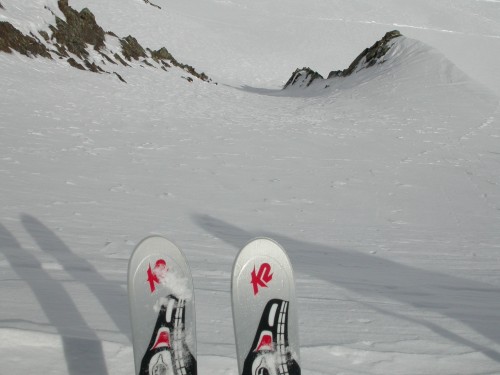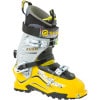6 – Trust Your Instincts
Part 6 in 10 of my personal avalanche avoidance theories..
Deciding to ski an avalanche slope based on gut instincts alone is a bad habit to get into, but there is one occasion when you definitely should trust your avalanche instincts: when they are telling you NOT to do it. This is akin to Spiderman’s spidey senses which buzz when danger is imminent, but are more like avalanche senses. If it is a green light day, low danger, nice slope, etc., and something just doesn’t feel right, it is worth listening to.

The one that got away… There was something about this chute that seemed weird to me, so instead of skiing it I took a photo and went elsewhere.
This phenomenon of something just seeming off is described in Malcom Gladwell’s book entitled “Blink” where among other examples, he details antiquities experts who recognize a fake statue at a glance. Gladwell describes this process as “thin-slice” filtering which helps focus in on the few factors that matter when you are overwhelmed with variables. In terms of snowpack, this could be anything from the surface texture, the way a certain slope is shaded, an odd looking lump or anything else that subconsciously sets off an alarm.
It is a fine line between confidence and stupidity, but if there is some nagging feeling, come back another day when it isn’t there.
________________________________
Help support StraightChuter.com and get some Intuition liner equipped Scarpa Rush Alpine Touring Boots from Backcountry.com. Click on the photo below…
Category: 07 Avalanche Avoidance










I was just in an avalanche instructor refresher course this weekend and we were discussing intuition. The more times you see a certain set of circumstances, the more likely later you are to recognize what the potential outcome is. An example is the a fire chief who orders everyone to leave a burning building moments before it collapsed, and afterwards was unable to say exactly why he made that call. But in his 30 year career he had seen more than 100 buildings collapse, and this time his brain processed all the tell tales signs from previous collapses and applied them to this incident.
I think it happens in the mountains too. With enough mileage, with experience, we start to get hunches and intuitions about what’s in front of us. You certainly seemed to have that moment as you looked into that chute – and after the 1000’s of days you’ve skied, I’m not surprised!
I always try to back-off a line every once in a while. Instead, I’ll ski something else (perhaps a lower angle or a different aspect), go home, and remember that it’s not a big deal. Better to try it again another day.
“Thinking Fast and Slow” by Daniel Kahneman should be required reading for all backcountry skiers.
A very important point: Intuition only works when you have a lot of experience in an instant-feedback environment. Otherwise, trusting your gut is probably the worst thing you can do because the human brain is plagued with dozens of biases and mental shortcuts that often steer us wrong. I cringe every time someone says “just trust your gut.” As usual, it depends…